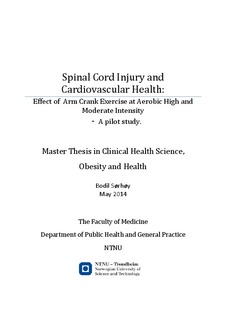Spinal Cord Injury and Cardiovascular Health: Effect of Arm Crank Exercise at Aerobic High and Moderate Intensity - A pilot study
Master thesis
Permanent lenke
http://hdl.handle.net/11250/281448Utgivelsesdato
2014Metadata
Vis full innførselSamlinger
Sammendrag
Background: Cardiovascular disease (CVD) is now the leading cause of death in individuals
with spinal cord injury (SCI). The SCI population is among the least physically active in
society. Physical activity is known to reduce risk factors for CVD. The role of intensity of
aerobic arm exercise in individuals with a chronic SCI is not fully investigated. Purpose: To
compare the effects from aerobic high intensity interval training (HIT) (85% - 95% of peak
heart rate (HR
peak
)) and isocaloric aerobic continuous moderate exercise (CME) (70% of
HRpeak
) on peak oxygen uptake (VO2peak
), waist circumference (WC) and endothelial function
measured as flow-mediated dilatation (FMD) in the brachial artery. Methods: 10 individuals
with SCI paraplegia were randomized to HIT or CME arm crank exercise three times a week
for eight weeks. Results: No significant differences in VO
2peak
between the groups from
baseline to post-test were found. However, there was a favorable trend towards a higher
increase in VO
2peak
in the HIT group compared to the CME group, 28.1±7.5 ml∙ kg
-1
∙min
-1
-31.2±8.8 ml∙ kg
-1
∙min
-1
versus 24.6±6.9 ml∙ kg
-1
∙min
-1
- 23.8±5.4 ml∙ kg
-1
∙min
-1
, respectively,
(P= 0.051). No difference in FMD or WC within or between the groups from baseline to posttest was found. Conclusions: The findings from the present pilot study showed no significant
difference between high- and moderate intensity arm crank exercise in terms of VO
2peak
, waist
circumference or flow-mediated dilatation. However, there was a favorable trend towards a
higher increase in VO
2peak
from arm crank exercise at aerobic high intensity compared to
isocaloric exercise at moderate intensit y. Exercise at aerobic high intensity was feasible for
the individuals with SCI paraplegia in this study. Future randomized studies with larger
sample sizes to confirm our findings are needed.
Relevance:
Evidence based practice is essential to assure the best possible quality of rehabilitation
medicine, and in this case, for the cardiovascular health of individuals with SCI paraplegia.
The findings from the present study may be incorporated into daily treatment routines, and
will contribute with new knowledge in the development of exercise guidelines for the SCI
population.
